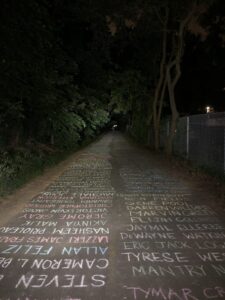
In late spring I rediscovered biking, as it’s a relatively Covid-safe exercise to help me keep fit during the pandemic. I live near the Minuteman Trail, and on a summer day, I can fit in a long ride during daylight hours before or after work. The path takes me through four towns – Cambridge, Arlington, Lexington, and Bedford. The trail is peppered with signage reminding riders of local ordinances requiring face masks, and like most riders I comply. But when I see an empty stretch of path ahead, I pull my mask down below my chin, sucking air into my mouth in greedy gulps, watching for people as I do. I readjust the mask over my mouth and nose as soon as I see another person ahead. I appreciate that careful consideration of each other has become protocol. I make a point to catch others’ eyes, sometimes “smizing” or nodding in acknowledgement: I am looking out for you, and I’m grateful you’re doing the same for me.

In late June, a long multi-colored list appeared on the path. Drawn in chalk, it was bidirectional and contained the names of people of color who were killed by police since 2013. I stopped biking to take it in, struck by the large colorful display that stretched as far as I could see. The festive chalk on pavement – reminiscent of youthful fun like foursquare and hopscotch – was incongruous with its grim message. Later I read a local news story, which said the list had 1,176 names, spanned 450 feet, and was drawn by a cohort of Arlington neighbors late at night and in the wee hours of the morning.[i] I was inspired by the care and effort the artists put into this ephemeral project. The rain washed away the bright dedication within a month. I felt wistful as I rode by the spot in July, watching its slow erosion.

I typically ride to the 8.5 milepost just beyond the bridge that goes over I-95, an arbitrary turning point that leaves me proud I biked 17 miles by the trip’s end. A couple weeks after the chalk memorial appeared, I noticed somebody had spray-painted “BLM” on the bridge. I imagine this graffiti artist noticed the memorial wearing away, longed for something more permanent, and resorted to the utilitarian indelible acronym, short for Black Lives Matter. It was likely written in haste. In the face of the protests and the racial inequities highlighted by the pandemic, I couldn’t blame the graffitist for wanting something more permanent. I’d attended multiple BLM rallies – another venue where almost everybody wears masks – so I felt a sense of solidarity. I found myself looking for the graffiti as I approached the bridge, solemnly acknowledging its significance, as I zipped over the highway.

Crossing the bridge one July morning I noticed somebody had repurposed the acronym. This graffitist had expanded BLM, vertically arranging the spray-painted words “black”, “loot”, and “murder” on the path. I was affronted by the conversion, frustrated that somebody felt compelled to so drastically change the original message’s intent. I knew this mini graffiti battle was reflective of society’s current racial tensions. When I took my usual ride two days later, I was relieved to see somebody else had spray-painted over the additional letters leaving the original BLM acronym intact. About a week after that, the BLM was also blackened out with spray paint.

Now when I take my usual ride, the chalk memorial is long gone, and spray paint squares are all that remain on the Bedford bridge, but I know this summer’s Minuteman Trail graffiti war history. I am grateful to whomever painted over the inflammatory counter-graffiti, and to the Arlington residents who wrote out the names of the 1,176 victims of police violence. Like us mask-wearers, these activists are looking out for others. I recall the vibrant list as I glide through East Arlington and imagine “BLM” as I whiz over the bridge, masked bikers passing by me, the Interstate traffic coursing below. I’m disappointed the written messages calling for racial justice are gone. Yes, Black lives do matter. Given the current heightened state of racial inequality, and stories about police violence, the statement is more significant than ever, and deserves to be disseminated on as many platforms as possible. And just as I feel a bond with the other bikers taking care to cover their faces, I feel a connection to the strangers who took the time to get that message out there.
[i] https://arlington.wickedlocal.com/news/20200629/minuteman-bikeway-art-project-memorializes-people-of-color-killed-by-police
photos from artsarlington.org
Article reprinted from: The Wire’s Dream Magazine
This piece is a nice way to recognize and honor those who are quietly looking out for others in their communities–rom trail users who wear masks not only for their own protection but for the safety of others, to Black Lives Matter supporters who go out of their way to protect vulnerable members of our communities. While the ravages of time and weather may have rendered the messages unreadable, I’m glad the pro-community messages triumphed over the single instance of hateful graffiti.
I am so happy to read this beautiful essay.